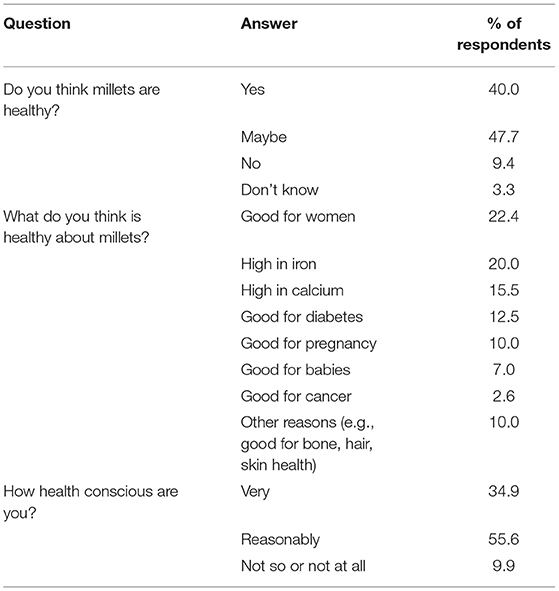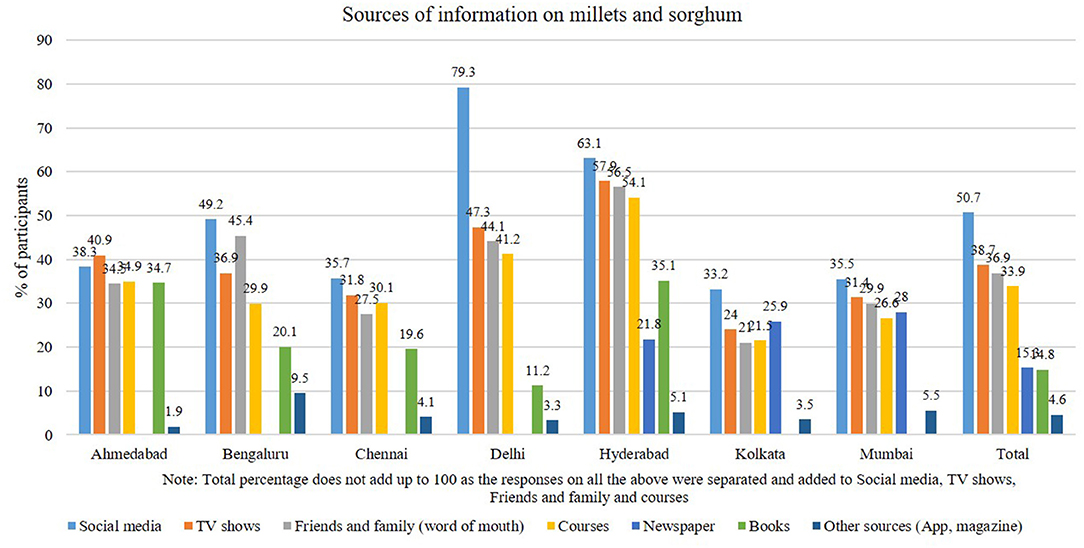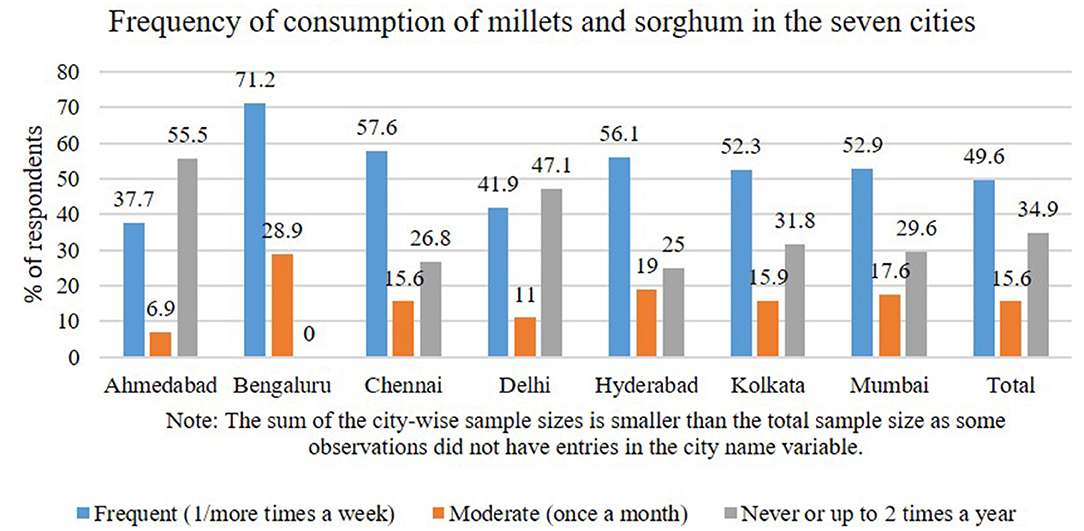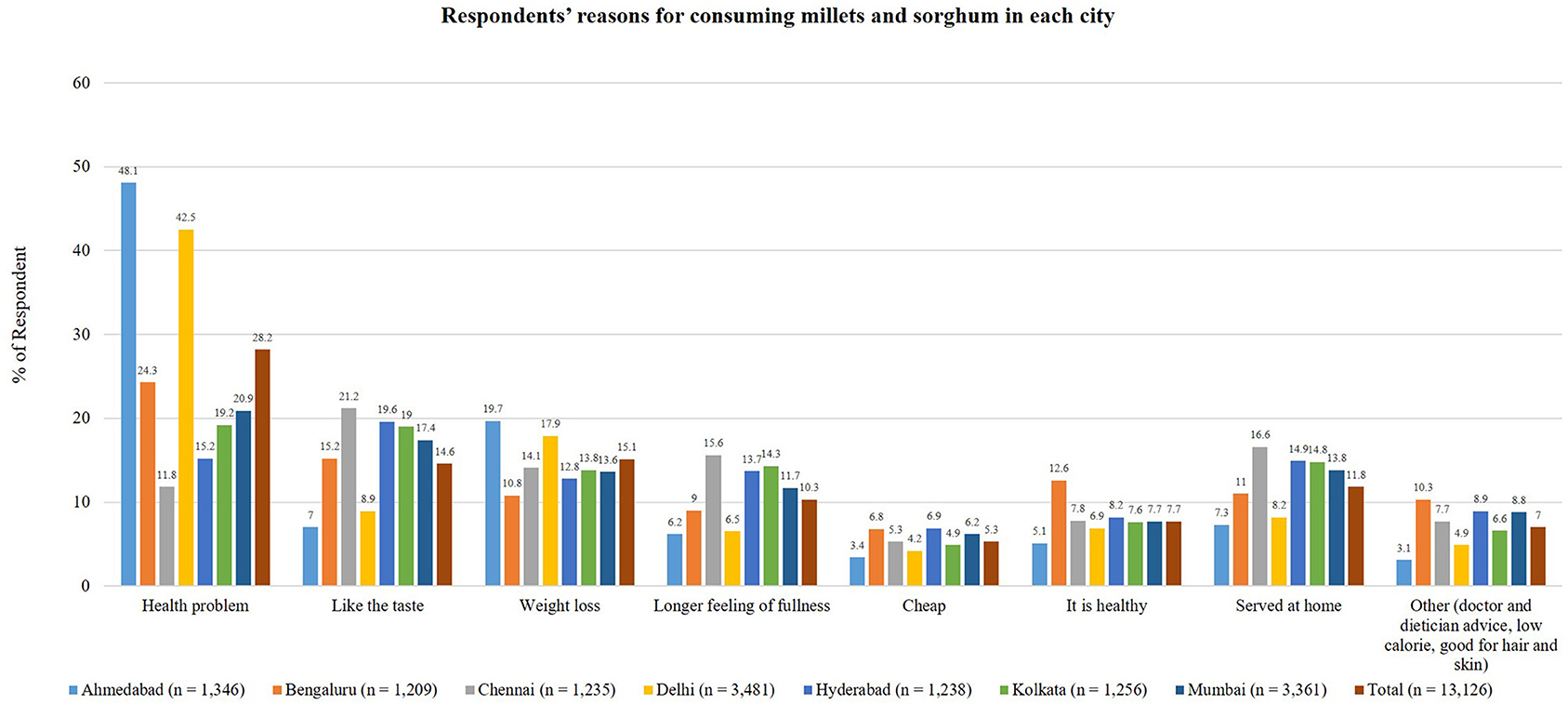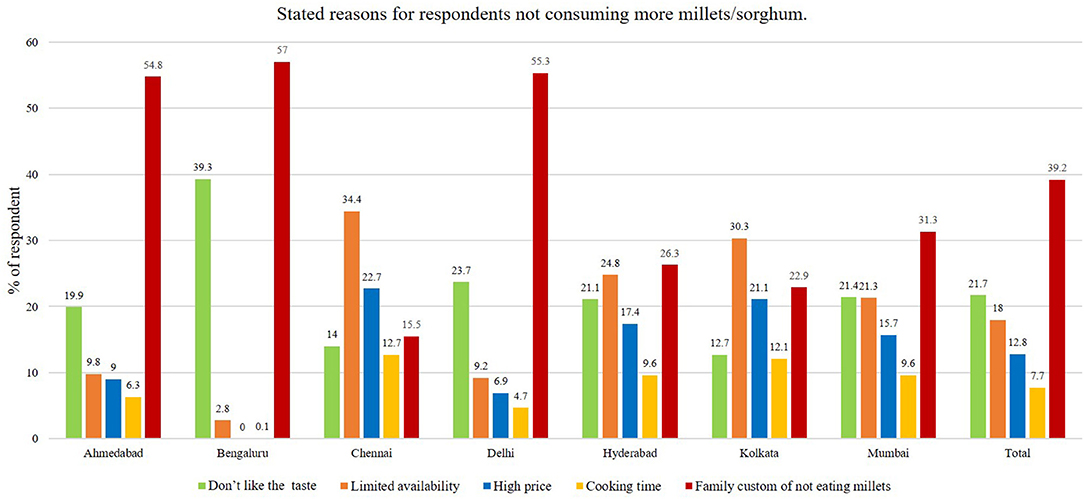- 1Smart Food Initiative, International Crops Research Institute for the Semi-Arid Tropics, Hyderabad, India
- 2Organization for Advanced and Integrated Research, Kobe University, Kobe, Japan
- 3Development Strategy and Governance Division, International Food Policy Research Institute, Lilongwe, Malawi
- 4United Nations International Children's Emergency Fund, Lilongwe, Malawi
- 5Marketing Leadership Institute, SR Global Media and Research Pvt. Ltd, Hyderabad, India
- 6Thought Folks Digital, Hyderabad, India
- 7Innovation Systems for the Dry Land, International Crops Research Institute for the Semi-Arid Tropics, Hyderabad, India
There is growing attention by governments and industry in regard to the role played by millets (including sorghum) to help build resilience for farmers and cope with climate change, malnutrition, diabetes, and some other major issues. To understand public knowledge and practices of consuming millets in urban areas, a survey was conducted with 15,522 individuals from seven major cities of India using a structured questionnaire, and after data cleaning 15,139 observations were subjected to analysis using descriptive and inferential statistics. It was found that the largest group among early adopters of millets were people with health problems (28%), it being the single largest reason for consuming millets, followed by those wanting to lose weight (15%) and those selecting millets for its taste (14%). There was a significant gap between people who were health conscious (91%) and those who were sure millets were healthy (40%). The major reason the respondents did not eat more millets was that it was not eaten at home (40%), followed by reactions such as not liking the taste (22%). Reaching the urban consumers through social media is recommended, given that it is their main source of information. There was no statistically significant relationship between state-wise per capita production and frequency of consumption of millets in the urban areas (p = 0.236). In conclusion, three key actions are recommended to enhance the consumption of millets: developing delicious products to satisfy the taste, providing knowledge on nutritional and health facts on millets, and improving accessibility of millets in urban markets.
Introduction
The recent paper from The Lancet Commissions (Willett et al., 2021) recognizes the need for identifying healthy and environmentally sustainable diets and enhanced usage of underused plant species, such as quinoa, millets, sorghum, or teff grains, due to their climate resilience and dense nutritional content. It also clearly captured that among 14,000 edible plants, only three crops, namely, rice, maize, and wheat, contribute 60% of caloric intake. On the other hand, the SDGs 2030 have its ambitious goal of eliminating all forms of malnutrition by 2030. To achieve this, interventions are required to replace the major portion of the diet currently occupied by rice, wheat, and maize with highly nutritious grains, such as millets.
In India and other Asian and African countries, millets commonly include sorghum, pearl millet, and a range of small millets (Vetriventhan et al., 2020). The term “millets” in this paper refers to all of these crops. India is the leading producer and consumer of different types of millets, such as finger millet, pearl millet, kodo millet, foxtail millet, barnyard millet, proso millet, and little millet (www.smartfood.org1,2). India is the sixth largest producer of sorghum globally (www.smartfood.org). Traditionally, many kinds of foods and beverages were made from these grains in different regions, which played an important role as a staple food in the local food culture. However, their presence in the Indian food basket has been declining over the years largely due to government policies favoring the production and consumption of fine cereals, such as rice and wheat (Kane-Potaka and Kumar, 2019), as well as rising incomes and urbanization. Between 1960 and 2015 in India, wheat production more than trebled, and rice production increased by ~800%; on the contrary, millet production was stagnant at low levels (Kane-Potaka and Kumar, 2019). Between 1962 and 2010, India's per capita consumption of millets fell drastically from 32.9 to 4.2 kg, while that of wheat almost doubled from 27 to 52 kg (www.indiaspend.com)3. Another study reported in particular on pearl millet that per capita consumption trend declined between 1972/1973 and 2004/2005 in both rural and urban regions of India from 11.4 to 4.7 and from 4.1 to 1.4 kg per year, respectively (Basavaraj et al., 2010). A similar declining trend in per capita consumption was reported for sorghum in both rural and urban India from 19.1 to 5.2 and from 8.5 to 2.7 kg per year, respectively, representing 68 and 70% reduction (Parthasarathy Rao et al., 2010).
Millets are often referred to as smart food (www.smartfood.org), which is “good for the individual” (nutritious and healthy), “good for the planet” (environmentally sustainable), and “good for the farmer” (resilient). Millets are recognized for their resilience, ability to survive under high temperatures and in degraded soils, and minimum requirements of water, pesticides, and fertilizers (Saleh et al., 2013). Their farming methods leave a lower carbon footprint than the major staples that are grown with greater use of fertilizers and pesticides. Millets complement commonly used legumes in India, such as pigeon pea and chickpea, for amino acid content to form complete protein with improved digestibility upon cooking (Anitha et al., 2019a). Apart from protein, depending on the variety and species, millets are also rich in minerals, such as iron, zinc, and calcium, which deliver health benefits to all age groups and genders.
The high nutritional content of millets compares well with other foods with similar nutritional value; it is especially high compared with polished rice, maize, and refined wheat flour, the post-green revolution major staples (Longvah et al., 2017). Innovative millet processing technologies that provide safe, easy-to-handle, ready-to-cook, and ready-to-eat products and meals at a commercial scale are mainly available in urban areas (Ushakumari et al., 2004), where rice and refined wheat flour dominate and are much more accessible and affordable. The consumption of refined grains, namely, refined white rice, is shown to be associated with non-communicable diseases, such as type II diabetes mellitus (Radhika et al., 2009) and obesity. This has led to an increasing emphasis globally on consuming whole grains (Edge et al., 2005), underlining the importance of mainstreaming nutritious smart food crops and promoting them as a staple. This is one of the major objectives of the Smart Food initiative (Singh and Raghuvanshi, 2012; Kane-Potaka, 2018). Providing more nutritious and healthier traditional whole grain and multigrain substitutes for refined carbohydrates can be an important aspect of therapeutic dietary modification and diversity.
There is a growing interest in reviving millets in India (Kane-Potaka and Kumar, 2019) and also globally, owing to their nutrition content and ability to grow in harsh climatic conditions due to their climate smart traits. The Government of India declared 2018 as a National Year of Millets and followed on with preparing a national Millet Mission, as well as a proposition to the Food and Agricultural Organization of the United Nations (UN) for a UN International Year of Millets. Several state governments in India also followed suit to establish state millet missions. These initiatives all recognized the need and built-in components to engage with consumers to drive demand and not only to invest in agricultural production and productivity. The demand for value added (processed) millet-based food products (being promoted as health foods) is increasing steadily in global markets (Rooney, 2010). This transition phase during which perceptions of millets are changing and there is greater health consciousness (Umanath et al., 2018) is the right stage to assess current knowledge, perceptions, and practices related to millets, which will lay the foundation for a plan to promote millets as a staple effectively.
Understanding current knowledge and practices is important for researchers, nutrition volunteers, community health workers, and food manufacturers in planning millet-based products, interventions, and promotional activities to improve the nutritional status and general health of the population and for companies to make nutritious foods a viable business. A limited number of studies have investigated the perceptions, awareness, and knowledge on millets. For instance, the study conducted on pearl millet, finger millet, and sorghum in Maharashtra state involved a relatively small sample of 111 participants who were all diabetic (Nambiar and Patwardhan, 2014). Another study on finger millet and oats in South India recognized the widespread lack of knowledge about the nutritional benefits of finger millet and the need to promote it through a survey with 260 women (Sreedhar and Shaji, 2017). To our knowledge, no formal study has focused on understanding consumers' knowledge, perceptions, and attitude on millets using a large sample survey covering various states of India. Therefore, this study aimed to assess the knowledge, perceptions, and practices of millets consumption in seven major cities of India.
Methods
A large sample survey was conducted to collect primary data on trends, attitudes, and opinions on millets consumption behavior of the target population who were urban consumers in India. The data were statistically analyzed to examine the relationship between variables (Creswell and Creswell, 2017). Surveys on beliefs, reasons, and barriers in purchase and consumption are widely used to evaluate food choice behavior (Roche et al., 2012; Irianto, 2015).
Survey Participants
Convenience sampling (Jager et al., 2017) was adopted where respondents were approached in shopping malls. This provided access to large numbers of men and women in cities in a short time at locations they commonly frequent for purchasing groceries. It also accessed shopping areas where targeted individuals purchased food ingredients for use at home. Participation in the survey was voluntary and anonymous. Participants were informed upfront of the purpose of the study and the use of the data, emphasizing that the information requested would be exclusively used for statistical analysis, guaranteeing confidentiality. Informed consent was obtained before the interview. To ensure confidentiality, the collected data were managed anonymously by providing sample identity based on institutional data management policy.
The optimal size of the survey sample was identified considering both the budget and the statistical power. As a result, a total of 15,522 individuals from seven cities in seven states of South, West, North, and East India participated in the survey. Approximately 300 survey personnel were deployed to conduct the interviews. The participants were provided with an information flyer and a link to an App about millets at the end of the survey.
Questionnaire
A structured questionnaire was developed with questions about millets including Food Frequency Questions (FFQ) on millet by custom designing to understand the millet consumption patterns [Usual Dietary Intakes: NHANES Food Frequency Questionnaire (FFQ) | EGRP/DCCPS/NCI/NIH (cancer.gov)], followed by socioeconomic information of the respondents (Supplementary Materials). An expert panel was consulted to ensure the validity and clarity of the questions. To ensure reliable results, the questionnaire was pre-tested with 20 subjects before the survey to validate and identify problems with the content and comprehensiveness of the questions, as well as other causes of (dis)satisfaction, which were added to the options sheet used by the interviewers. Based on the satisfaction or dissatisfaction, annotations, and comments from the pre-testing, the questionnaire was improved and finalized, which helped ensure that the questions were understood by both interviewers and respondents and minimize subsequent measurement errors.
The survey was administered to visitors to shopping malls over the course of August 2017. Participants were asked the questions in person about their knowledge, perceptions, and consumption patterns, as well as the reasons for their practices and sources of information, on millets.
All the qualitative and quantitative questions were asked without prompts or options to select. The interviewees had options on the question sheet to assist with faster recording, and additional answers were written. These options were collated from pilot testing of the questions, and the options for demographics were based on common standards. A picture of three popular smart food grains, namely, finger millet, pearl millet, and sorghum, was used as a visual aid at the beginning of the survey along with a structured questionnaire. The picture included the crop and the grain with their names in English, Hindi, and the state language. The income of a participant's household was self-reported and included a variety of questions designed based on standard methods for grouping participants in poor, middle, and rich income groups (Dalvi et al., 2020).
Data Analysis
Data were cleaned, organized, coded, and subjected to statistical analysis using STATA version 16 (StataCorp, 2019). After data cleaning, 15,139 observations were subjected to analysis (Table 1). However, the tables of results may include a smaller number of observations depending on the number of missing observations in the variables included in the specific analysis. Descriptive statistics, such as frequency, mean, median, and standard deviation, were used to present the knowledge and practices among participants. Inferential statistical tools, such as tetrachoric correlation, Z-statistics, and ordered probit regression (Daykin and Moffatt, 2010), were performed to examine the influence of various factors on consumption habits and perceptions toward millets. The dataset is currently stored in Dataverse and managed by ICRISAT (https://doi.org/10.21421/D2/JUMRM8).
Results
Gender
Among the respondents, 9,453 were women and 5,686 were men, and their average age was 41.2 years. Overall, a higher proportion of women were interviewed as they constituted the majority of grocery shoppers in the town (Table 1). In particular, women constituted an even higher proportion of grocery shoppers in Ahmedabad and Delhi.
Recognition of Millets
Although not presented in the table, 89% of the participants reported that they knew millets. Among the participants who responded “yes” to consuming millets, most of them did not recognize it when shown the picture of sorghum, pearl millet, and finger millet (Supplementary Figure 1). An example response from a 28-year-old female was “I have been drinking ragi malt (a milk drink made from finger millet) almost every day for the past 3 years since my first pregnancy, but I had no idea what ragi (finger millet) looked like, and today, I see it in the picture that you showed to me, and this is fabulous, and thanks to smart food for all the good work.”
Although not shown in the table, among the three crops, sorghum had the highest recognition rate (59.3%) when shown images of the crop and the grain, followed by finger millet (54.8%). There was no difference in recognition of millets between age groups, though these crops were a traditional staple. To our surprise, the youngest group, below 20 years, had similar or higher recognition of the crops, especially pearl and finger millets, than other age groups.
Recognition of all the three crops among both women and men was the highest in Mumbai, followed by Bengaluru, the lowest being in Kolkata (Table 2).
Awareness of Nutritional Value
It was identified that the awareness of millets was prevalent in the last 4 years, and that more than 23% of the respondents mentioned they had heard about or started eating millets <5 years before.
When asked whether they thought millets were healthy, less than a half (40%) of the respondents were sure that millets were healthy (Table 3). On being asked what they thought was healthy about millets, the answers included: it is good for the general health of women (22%), is high in iron (20%), is high in calcium (15.5%), and is good for diabetes (12.5%). The rest of the participants (30%) thought that it was good for bone health, cancer, during pregnancy, and for babies (Table 3). Most (91%) of the respondents said that they were reasonably or highly health conscious (56.6 or 34.4%, respectively; Table 3).
Sources of Information
When asked what their source of information on health and foods was, by far the most influential was social sources, the largest being social media with 50.7% of the participants opting for it, while TV shows were the sources for 38.7%, and family and friends were the sources for 36.9%. The other influential information sources were courses (33.9%), newspapers (15.3%), and books (14.8%; Figure 1).
Consumption
Although there was a considerable proportion of consumers eating millets frequently (49.6% consumed 1 or more times per week), there was also a reasonable proportion of people who had never or almost never consumed millets (34.9% consumed millets never or up to two times a year; Figure 2). The city-wise frequency of consumption of millets was linked to the recognition of these crops in each city, as shown in Table 3. Bengaluru led in terms of consumption, while Ahmedabad and Delhi had the lowest consumption frequencies. In Bengaluru, no respondent mentioned that they never/rarely consumed millets. In fact, it was the only city where all the respondents consumed these crops at least once a month. Approximately 71.2% of the respondents in Bengaluru consumed millets at least once a week. This was followed by 57.6 and 56.1% of the respondents being frequent consumers and 26.8 and 25% never/rarely consuming millets in Chennai and Hyderabad, respectively. Mumbai and Kolkata ranked next with 52.9 and 52.3% being frequent consumers and 29.6 and 29.6% never/rarely consuming. Delhi and Ahmedabad had the lowest frequency of consumption with 41.9 and 37.7% consuming frequently and 47.1 and 55.5% never/rarely consuming millets, respectively (Figure 2). This indicates that South India is a much greater consumer of millets.
How Millets Are Eaten
The most common form in which millets were eaten at the pan India level was as ready-to-eat food, as reported by 45.6% of the respondents. Breakfast porridge, which is one of the traditional forms of consumption, stood at the top at 38.3%. Ahmedabad and Bengaluru had the largest consumption of ready-to-eat food, with up to 65.7 and 63.4% of the respondents saying that this was the most common form in which they consumed millets (Figure 3).

Figure 3. Common forms in which millets are eaten by participants of the survey in different cities of India.
Reasons for Consumption
Figure 4 presents the reasons stated for the consumption of millets. The major reason at the pan India level was the prevalence of health problems including but not limited to diabetes, heart conditions, bone health, and general health. The proportion was especially large in Ahmedabad (48.1%) and Delhi (42.5%). The only two cities where this was not the number one reason were Chennai and Hyderabad, where taste preference was the major reason for eating millets. The second major reasons for eating millets pan India were for weight loss (15.1%) and its taste (14.6%).
However, the reason for eating it based on taste preference was not consistent across cities and ranged widely (7–21%); it was predominant in Ahmedabad and Delhi that had lower frequency of consumption. Health and fitness were together chosen as the major reasons for eating millets by at least 58.0% of the respondents. However, few said that they ate it just because it was healthy (7.7%); this trend was consistent across all the cities, ranging from 5.1 to 12.6%. This indicates that a specific health problem is an influential driver for people to eat millets, rather than just because millets are healthy. More women tended to attribute their consumption of millets to health issues and weight loss (Table 4), while men tended to consume it simply because it was served at home. Furthermore, low income respondents tended to consume millets for the taste and subsistence and not to lose weight; neither did they find millets cheap.
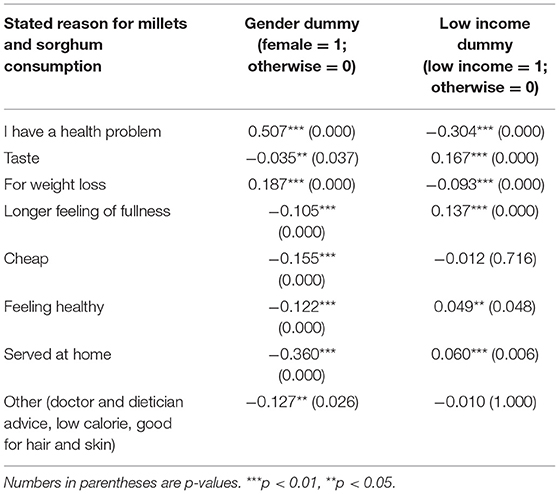
Table 4. Relationship between reasons for consuming millets and sorghum and the demographic profile of the respondents: tetrachoric correlation coefficients and p-values (n = 15,513).
The most prevalent health reasons for eating millets included weight loss (the top ranked reason especially a primary reason by women 30–50 years old); diabetes (many diabetic patients said that their doctor had recommended eating millets); blood pressure; cancer; skin diseases (this was noted particularly from Bangalore and Mumbai participants who believed that sorghum and finger millet were good for skin and hair growth, and some doctors who participated in the survey said that they ate finger millet a few times a week for better skin); eye sight problem; stronger bones; and healthy pregnancy and baby growth.
Reason for Not Consuming More
The survey further enquired why people did not consume (more) millets. Overall, the family eating custom at home was the most frequently stated reason by nearly 40% of the respondents. Only Kolkata and Chennai differed in this trend, both citing limited availability as the key reason and its high price as another. It is worth noting that only 3% of the respondents in Bengaluru cited limited availability of millets as a concern, as the state is the largest producer of millets in India. Kolkata and Chennai had smaller production of millets. Chennai was also the place where respondents had the lowest awareness of all three millets. In Bengaluru, the major reasons cited for not eating (more) millets were their taste and family dietary customs. Pan India, the second major reason for not consuming more millets was the taste, cited by 22% of the respondents. Cooking time of millets was of significance in all the cities (Figure 5).
Table 5 shows the tetrachoric correlation between the reasons stated for infrequent consumption of millets and the demographic profile of the respondents. Unexpectedly, women who did not frequently consume millets tended to attribute it to a dislike of the taste and family custom, while men attributed it to the limited availability, high price, and long cooking time. Both low and high income groups showed similar tendencies, whereas the middle income group exhibited a distinct set of dispositions. The latter group, when not consuming millets frequently, attributed it to unfavorable taste and family custom. Table 6 shows the Spearman's non-parametric correlation between the frequency of consumption and the reasons stated for not increasing the frequency. Those who consumed less frequently were more likely to mention family custom as the reason. In contrast, those who consumed more frequently tended to mention taste, high price, non-availability in markets, and long cooking time as reasons for not increasing the frequency of consumption.

Table 5. Tetrachoric correlation between respondents' reasons for not consuming millets/sorghum and their demographic profile.
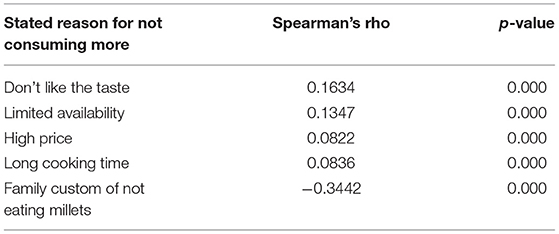
Table 6. Spearman's coefficient of correlation between frequency of consumption and their reason for not consuming more millets and sorghum (n = 13,840).
Production and Consumption
Table 7 shows the state-level production of millets, as well as their levels of consumption, in the cities studied. Karnataka was the largest producer of these crops, followed by Maharashtra, Gujarat, and Tamil Nadu, confirming the concentration of production in southern states of India. Except in Gujarat, urban consumers in Karnataka and Maharashtra consumed these crops at relatively high frequency, with “once or twice a week” being the median. Despite Gujarat being the largest producer of pearl millet, it exhibited the smallest consumption, clearly showing that its large production had little impact on urban consumption. On the other hand, consumers in Delhi consumed these crops moderately (once a month), but their production was small. In contrast to these cities, Telangana and West Bengal consumed millets frequently despite less production.

Table 7. Production (tons) of millets and sorghum per state population in 2015–2016 and their frequency of consumption.
Table 8 examines how state-wise per capita production was related to the frequency of consumption of millets through ordered probit regression. The covariates included in the model were the age dummy, gender dummy, and income dummy. The standard errors were clustered at the site level to account for intra-site repetition in the value of production. The results showed no statistically significant relationship between state-wise per capita production and the frequency of consumption in the urban areas, where age, gender, and income factors were controlled for. Lastly, younger people and women consumed millets less frequently, whereas people with low incomes consumed millets more frequently. An investigation of the distributional effects (Table 9) to ascertain the marginal effects of state-wise per capita production on different levels of consumption frequency revealed that production and consumption exhibited a U-shaped non-linear relationship, suggesting that older people consumed more millets when the consumption level is in the low range. Likewise, being a woman and having low income was associated with consuming the crops less frequently.
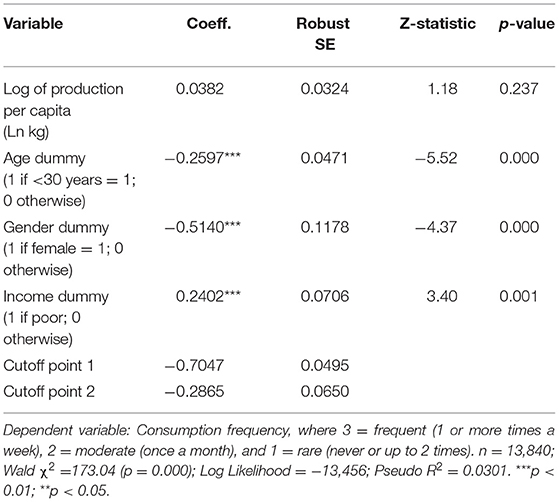
Table 8. Frequency of consumption of millets and sorghum and production per state population: ordered probit regression.

Table 9. Marginal effects of state-wise per capita production of millets and sorghum on log odds of frequency of consumption in the urban areas (n = 13,840).
Discussion and Policy Implications
Millet campaigns and promotions implemented in the past few years may be the reasons for the higher recognition of millets among the young age group. The individual ability to recognize millets varied across states, in line with the diverse agro-ecologies and contrasting cropping patterns across India (Tsusaka and Otsuka, 2013). Frequent consumers were in Bengaluru, which is not surprising given its reputation for being an advanced city for organic and health foods including millets (Anbukkani et al., 2017). It may be noted that Karnataka state, of which Bengaluru is the capital, was the first Indian state to have a Millet Mission and to launch the annual national millet fair in January 2017, which promoted traditional millets to be brought back as staples and popular modern food.
Although millets can be easily incorporated into almost all popular rice- and wheat-based recipes, one of the reasons for not consuming millets regularly is the lack of knowledge on how to incorporate or cook them. Currently, a few recipes are widely used in communities to cook millets. These include finger millet balls, finger millet porridge, millet chapattis/rotis, and finger millet malt. The relationship between demographic characteristics and the attitude of farm women toward value-added products of finger millet were studied previously (Kowsalya et al., 2017), wherein it was concluded that when farm women were well-trained, there was a favorable attitude toward value addition of finger millet-based products. This, along with the consumer survey results, suggests the need for training on value addition for traditional smart foods, such as millets (Anitha et al., 2019a,b), and that preparing millets in a culturally appropriate manner helps in improving their acceptability. The model for introducing millets in communities and schools in an acceptable manner and how they can change perceptions and influence food preferences in a positive manner have been demonstrated previously (Diama et al., 2020; Wangari et al., 2020). Equally important is understanding the initial knowledge, practices, and individual attitude toward these traditional crops while planning and implementing any nutrition-related interventions using them. A study (Singh and Raghuvanshi, 2012) on knowledge, perceptions, and practices by 111 diabetes individuals reported that 55% of the participants consumed millets because it was a habit from childhood and only 26% of them reported that they ate it because they liked it. However, 11% of the respondents reported that they had no reason to consume millets. The reason for not consuming these grains was either because they were not prepared at their homes (20%) or were not part of their food from childhood (26.6%). Some of them reported that it was advised not to consume them, and 20.6% of them reported that there was no particular reason to not consume them. This shows that if millets were not eaten from childhood, there was no incentive or trigger for consuming them, hence the importance of raising awareness and inculcating good practices from childhood in order to develop a healthy population. However, the current study clearly demonstrated that the major reason for consuming millets was the prevalence of a health issue. A small percentage of people (11.8%) said that it was consumed due to the habit of it being eaten at home; while a significant percentage of people (39.2%) said they did not eat millets because of cultural habits of it not being eaten at home. This highlights the importance of influencing attitudes and practices for millets to become a common food in the household, resulting in more consumption. The result also shows that targeting the person/people who most influence what is eaten at home can have a multiplier effect on consumption.
In summary, health- and wellness-related issues were by far the major factors influencing consumption of millets in urban areas, with 58% of the interviewees stating so. Consumers with a health issue seemed to be the lowest hanging fruit with regard to market segments that were early adopters of millets, especially women. Consumers wanting to lose weight were also early adopters, again especially among women. Similar results were observed in the previous studies on consumer motives, attitude and purchase preferences for health and organic food products, showing that the health factor was the most important motive behind their selection and purchase (Syah and Yuliati, 2017; Nandi et al., 2016).
Furthermore, a large gap was identified between people who were health conscious (91%) and those who knew that millets were healthy (40%; Figure 6). While some health benefits of millets were recognized, such as its role in preventing lifestyle-related non-communicable diseases, there were several other health benefits not well-known previously. A recent systematic review and global meta-analysis of 65 studies on 11 types of millets shows that millets help manage and reduce the risk of developing type 2 diabetes (Anitha et al., 2021a). Another systematic review and meta-analysis of 19 studies shows that long-term consumption of millets can reduce cholesterol, triglyceride, low-density lipoprotein cholesterol (LDL-C), very low-density lipoprotein cholesterol (VLDL-C), high-density lipoprotein cholesterol (HDL-C), body mass index (BMI), and hypertension, which is another piece of evidence of its potential in reducing the risk of developing cardiovascular diseases (Anitha et al., 2021b). Their richness in iron also helps in improving hemoglobin levels and iron status of the body (Anitha et al., 2021c). In particular, finger millet is rich in calcium and zinc, which are essential for growth and immunity. These nutritional and therapeutic effects of millets are vital and provide alternative ways to solve some of the global public health issues. The proportion of people aware of health benefits of millets being 40% implies a large proportion of potential consumers and a significant knowledge gap. This result is also supported by an earlier study in Tamil Nadu that people had little knowledge of millets in comparison with oats (Sreedhar and Shaji, 2017). Learning the actual health and nutritional benefits would increase consumption of millets. It is recognized that reaching the mainstream market may be challenging and would require more than just awareness raising.
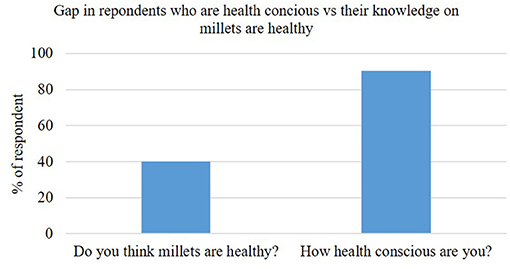
Figure 6. Gap in respondents who are health conscious vs. their knowledge on millets health benefit.
However, as family customs strongly influence what people eat at home, influencing the decision makers at households would have a ripple effect on consumption and be a major way to reach male consumers. Taste was observed to be a major reason why the respondents did/did not eat more millets, indicating that health awareness alone would not significantly boost millet consumption. Together, these insights showed the need for tasty products and simple recipes made from millets. As millets are mostly eaten as traditional porridge, there seem to be abundant opportunities to grow the market through ready-to-eat and ready-to-cook convenience foods and cookies, among others.
Overall, it is recognized that the market for millets would expand with appropriate awareness campaigns targeting different segments, especially through social media channels that were found to be the major sources of information on health and food. It would also be important to introduce tasty, modern, and convenient products into markets that are more easily accessible.
The findings of this study may be useful for policymakers as well as different stakeholders, e.g., food companies, government entities, nutritionists, development organizations, and researchers, who intend to promote consumption of millets under various government programs by improving awareness and delivering marketing campaigns. Specific consumer segments should be identified based on the research evidence, while the understanding of consumer awareness and rationale for eating or not eating millets may potentially be valuable inputs to public health debate. In particular, this may be useful for the Government of India Millet Mission, individual state Millet Missions, and the potential upcoming UN International Year of Millets (2023). The information may also help design nutrition behavioral change programs in urban settings.
The shopping centers where the surveys were conducted had good footfalls, with a wide variety of visitors. Nevertheless, the data were geographically localized, and the interviewees resided mainly in major urban cities. Future studies should attempt to obtain similar data on consumption, knowledge, and attitudes at the rural and peri-urban levels to compare various consumer segments and to develop better understanding of millet utilization. Moreover, repeated studies should be conducted to track these changes over time and the influences on changed behavior.
Conclusion
Little has been formally studied about urban consumers' knowledge, attitudes, and practices related to millets despite growing health consciousness among people, increasing non-communicable diseases in India, and the nutritional potential of millets. The survey involving over 15,000 face-to-face interviews across seven major cities in India is arguably the largest survey on consumers about millets. A key aim of this study was to understand the motivation of consumers and how best to position millets in any campaigns while planning agriculture-based nutrition interventions to improve the market, consumption, and nutritional status. The findings imply a need to more actively promote the benefits of millets and to create awareness of various ways of cooking millets or creating millet products to satisfy taste preferences and change the perception of millets, which would in turn lead to an increase in their consumption.
Data Availability Statement
The original contributions presented in the study are included in the article/Supplementary Materials, further inquiries can be directed to the corresponding author/s.
Ethics Statement
Ethical review and approval was not required for the study on human participants in accordance with the local legislation and institutional requirements. The participants provided their written informed consent to participate in this study.
Author Contributions
JK-P: conceptualization, methodology, investigation, review and editing, and resources. SA, TWT, and RB: validation, formal analysis, data curation, and writing original draft. KM, RH, and MB: methodology, validation, and first analysis. SU, PK, SN, and AJ: writing—review and editing. All authors contributed to the article and approved the submitted version.
Funding
This research was funded by Smart Food endowment fund, ICRISAT.
Conflict of Interest
KM was employed by company SR Global Media and Research Pvt. Ltd. RH was employed by Thought Folks Digital.
The remaining authors declare that the research was conducted in the absence of any commercial or financial relationships that could be construed as a potential conflict of interest.
Publisher's Note
All claims expressed in this article are solely those of the authors and do not necessarily represent those of their affiliated organizations, or those of the publisher, the editors and the reviewers. Any product that may be evaluated in this article, or claim that may be made by its manufacturer, is not guaranteed or endorsed by the publisher.
Acknowledgments
This work was undertaken as part of the Smart Food initiative led by ICRISAT, FARA, CORAF, FANRPAN, and APAARI and coordinated jointly in India with IIMR. The authors are grateful to a range of people for their inputs: the expert panel for reviewing the survey—Ravula Padmaja, Jerome Bossuet, and Carl Hinrichsen (ICRISAT staff/consultants) and Sridhar Iriventi (Founder and Managing Director of Go Bharathi Agro Industries); and Ismail Mohamad (ICRISAT) for generating the map.
Supplementary Material
The Supplementary Material for this article can be found online at: https://www.frontiersin.org/articles/10.3389/fsufs.2021.680777/full#supplementary-material
Footnotes
1. ^Learning from the Web. Available online at: http://www.smartfood.org/
2. ^Learning from the Web. Available online at: https://www.smartfood.org/millets-sorghum-%20production-trends/
3. ^Learning from the Web. Available online at: (https://archive.indiaspend.com/cover-story/a-millets-revival-could-solve-indias-malnutrition-problem-benefit-farmers-31717)
References
Anbukkani, P., Balaji, S. J., and Nithyashree, M. L. (2017). Production and consumption of minor millets in India- a structural break analysis. Ann. Agric. Res. 38, 1–8.
Anitha, S., Botha, R., Kane-Potaka, J., Givens, D. I., Rajendran, A., Tsusaka, T. W., et al. (2021b). Can millet consumption help to manage hyperlipidaemia and obesity - a systematic review and meta-analysis. Front. Nutr. doi: 10.3389/fnut.2021.700778
Anitha, S., Govindaraj, M., and Kane-Potaka, J. (2019a). Balanced amino acid and higher micronutrients in millets complements legumes for improved human dietary nutrition. Cereal Chemistry. 1-11. doi: 10.1002/cche.10227
Anitha, S., Htut, T. T., Tsusaka, W. T., Jalagam, A., and Kane-Potaka, J. (2019b). Potential for smart food products: use of millets and pigeonpea to fill the nutrition gap in rural Myanmar. J. Sci. Food Agric. 100, 394–400. doi: 10.1002/jsfa.10067
Anitha, S., Kane-Potaka, J., Botha, R., Givens, D. I., Binti Sulaiman, N. L., Upadhyay, S., et al. (2021c). Millets can have a major impact on improving iron status, haemoglobin level and in reducing iron deficiency anaemia - a systematic review and meta-analysis. Front. Nutr. Submitted.
Anitha, S., Kane-Potaka, J., Tsusaka, T. W., Botha, R., Rajendran, A., Givens, D. I., et al. (2021a). A systematic review and meta-analysis of the potential of millets and sorghum for managing and preventing diabetes mellitus. Front. Nutr. doi: 10.3389/fnut.2021.687428
Basavaraj, G., Parthasarathy Rao, P., Bhagavatula, S., and Ahmed, W. (2010). Availability and utilization of pearl millet in India. J. SAT Agric. Res. 8, 1–7.
Chandramouli, C. (2011). Census of India 2011. Office of Registrar General and Census Commissioner. Available online at: http://www.census2011.co.in (accessed February 14, 2020).
Creswell, J. W., and Creswell, J. D. (2017). Research Design: Qualitative, Quantitative, and Mixed Methods Approaches. Thousand Oaks, CA: Sage Publications.
Dalvi, M. T., Khairnar, R. M., and Kalghatgi, R. S. (2020). An update of B.G. Prasad and Kuppuswamy Socio economic status classification scale for Indian population. Indian J. Pediatr. 87, 567–568. doi: 10.1007/s12098-020-03200-7
Daykin, R. A., and Moffatt, G. P. (2010). Analyzing ordered responses: a review of the Ordered Probit Model. Understand. Stat. 1, 157–166. doi: 10.1207/S15328031US0103_02
Diama, A., Anitha, S., Kane-Potaka, J., Htut, T. T., Jalagam, A., Kumar, P., et al. (2020). “How the Smart Food concept can lead to transformation of food systems and combat malnutrition? - different approaches in Africa, globally, and a case study from Myanmar with lessons learnt for creating behavior change in diets,” in Hidden Hunger and the Transformation of Food Systems. How to Combat the Double Burden of Malnutrition?, ed H. K. Biesalski (Basel: Karger), 149–158. doi: 10.1159/000507494
Edge, M. S., Jones, J. M., and Marquart, L. (2005). A new life for whole grains. J. Am. Dietet. Assoc. 105, 1856–1860. doi: 10.1016/j.jada.2005.10.022
Irianto, H. (2015). Consumers' attitude and intention towards organic food purchase: an extension of theory of planned behavior in gender perspective. Int. J. Manage. Econ. Soc. Sci. 4, 17–31.
Jager, J., Putnick, D. L, and Bornstein, M. H. (2017). More than just convenient: the scientific merits of homogeneous convenience samples. Monogr. Soc. Res. Child Dev. 82, 13–30. doi: 10.1111/mono.12296
Kane-Potaka, J. (2018). “Breaking the food-system divide with Smart Food: good for you, the planet and the farmer: reshaping agriculture for better nutrition,” in The Agriculture Food Nutrition Health Nexus, Proceedings of the Crawford Fund 2018 Annual Conference (Canberra, ACT), 13–14. Available online at: https://www.crawfordfund.org/wp-content/uploads/2019/01/2018-Crawford-Fund-Conference-Proceedings.pdf
Kane-Potaka, J., and Kumar, P. (2019). “Smart food - food that is good for you, the planet and the farmer,” in State of India's Livelihoods Report 2019 (New Delhi: Access Development Services), 71–82. Available online at: https://livelihoods-india.org/publications/all-page-soil-report.html#; www.smartfood.org/wp-content/uploads/2020/05/SOIL-Smart-Foods.pdf
Kowsalya, K. S., Lalitha, K. C., Preethi, and Ahmed, T. (2017). Impact of demographic characteristics on attitude of farm women towards value added products of ragi. Int. J. Curr. Microbiol. Appl. Sci. 6, 1188–1194. doi: 10.20546/ijcmas.2017.603.138
Longvah, T., Ananthan, R., Bhaskarachary, K., and Venkaiah, K. (2017). Indian Food Composition Table. Hyderabad: National Institute of Nutrition.
Nambiar, S. V., and Patwardhan, T. (2014). Millets in diabetes - Emic Views. Int. J. Pure Appl. Biosci. 2, 89–97.
Nandi, R., Bokelmann, W., Gowdru, N. V., and Dias, G. (2016). Consumer motives and purchase preferences for organic food products: empirical evidence from a consumer survey in Bangalore, South India. J. Int. Food Agribus. Market. 28, 74–99, doi: 10.1080/08974438.2015.1035470
Parthasarathy Rao, P., Basavaraj, G., Ahmad, W., and Bhagavatula, S. (2010). An analysis of availability and utilization of sorghum grain in India. J. SAT Agric. Res. 8, 1–9.
Radhika, G., Van, D. M. R., Sudha, V., Ganesan, A., and Mohan, V. (2009). Refined grain consumption and the metabolic syndrome in urban Asian Indians (Chennai Urban Rural Epidemiology Study 57). Metab. Clin. Exp. 58, 675–681. doi: 10.1016/j.metabol.2009.01.008
Roche, E., Conner, D., Kolodinsky, M. J., Buckwalter, E., Berlin, L., and Powers, A. (2012). Social cognitive theory as a framework for considering farm to school programming. Childhood Obes. 8, 357–363. doi: 10.1089/chi.2012.0035
Rooney, L. W. (2010). “Virtues of sorghum: utilization and supply chain management,” in INTSORMIL Presentations. Available online at: https://digitalcommons.unl.edu/intsormilpresent/28
Saleh, S. M. A., Zhang, Q., Chen, J., and Shen, Q. (2013). Millet grains: nutritional quality, processing, and potential health benefits. Comprehens. Rev. Food Sci. Food Saf. 12, 281–295. doi: 10.1111/1541-4337.12012
Singh, P., and Raghuvanshi, R. S. (2012). Finger millet for food and nutritional security. Afr. J. Food Sci. 6, 77–84. doi: 10.5897/AJFSX10.010
Sreedhar, S. K. P., and Shaji, S. (2017). Comparative KAP study on ragi, a forgotten wonder grain with oats among South Indian families. Curr. Res. Diab. Obes. J. 3, 1–4. doi: 10.19080/CRDOJ.2017.03.555601
Syah, A., and Yuliati, L. N. (2017). The influence of values and attitude toward healthy food selection at student of Bogor Agricultural University. J. Consum. Sci. 2, 57–65. doi: 10.29244/jcs.2.2.57-65
Tsusaka, W. T., and Otsuka, K. (2013). “The declining impacts of climate on crop yields during the Green Revolution in India: 1972 to 2002,” in An African Green Revolution: Finding Ways to Boost Productivity on Small Farms, eds K. Otsuka and D. F. D. Larson (dordrecht: Springer), 71–94. doi: 10.1007/978-94-007-5760-8_4
Umanath, M., Balasubramaniam, R., and Paramasivam, R. (2018). Millets consumption probability and demand in india an application of heckman sample selection model. Econ. Affairs 63, 1033–1044. doi: 10.30954/0424-2513.4.2018.29
Ushakumari, R. S., Latha, S., and Malleshi, G. N. (2004). The functional properties of popped, flaked, extruded and roller-dried foxtail millet (Setaria italica). Int. J. Food Sci. Technol. 39, 907–915. doi: 10.1111/j.1365-2621.2004.00850.x
Vetriventhan, M., Azevedo, V. C. R., Upadhyaya, H. D., Kane-Potaka, J., Anitha, S., Prabhakar Govindaraj, M., et al. (2020). Genetic and genomic resources, and breeding for accelerating improvement of small millets: current status and future interventions. Nucleus 63, 217–239. doi: 10.1007/s13237-020-00322-3
Wangari, C., Mwema, C., Siambi, M., Silim, S., Ubwe, R., Malesi, K., et al. (2020). Changing perception through a participatory approach by involving adolescent school children in evaluating Smart Food dishes in school feeding programs real-time experience from Central and Northern Tanzania. Ecol. Food Nutr. 59, 472–485. doi: 10.1080/03670244.2020.1745788
Keywords: millets, sorghum, health benefit, knowledge and practice, consumer behavior
Citation: Kane-Potaka J, Anitha S, Tsusaka TW, Botha R, Budumuru M, Upadhyay S, Kumar P, Mallesh K, Hunasgi R, Jalagam AK and Nedumaran S (2021) Assessing Millets and Sorghum Consumption Behavior in Urban India: A Large-Scale Survey. Front. Sustain. Food Syst. 5:680777. doi: 10.3389/fsufs.2021.680777
Received: 15 March 2021; Accepted: 29 June 2021;
Published: 13 August 2021.
Edited by:
Giuseppe Di Vita, University of Turin, ItalyReviewed by:
Aida Turrini, Independent Researcher, Rome, ItalyGabriele Carullo, University of Siena, Italy
Copyright © 2021 Kane-Potaka, Anitha, Tsusaka, Botha, Budumuru, Upadhyay, Kumar, Mallesh, Hunasgi, Jalagam and Nedumaran. This is an open-access article distributed under the terms of the Creative Commons Attribution License (CC BY). The use, distribution or reproduction in other forums is permitted, provided the original author(s) and the copyright owner(s) are credited and that the original publication in this journal is cited, in accordance with accepted academic practice. No use, distribution or reproduction is permitted which does not comply with these terms.
*Correspondence: Seetha Anitha, cy5hbml0aGFAY2dpYXIub3Jn; ZHIuYW5pdGhhc2VldGhhQGdtYWlsLmNvbQ==
 Joanna Kane-Potaka
Joanna Kane-Potaka Seetha Anitha
Seetha Anitha Takuji W. Tsusaka
Takuji W. Tsusaka Rosemary Botha
Rosemary Botha Muralidhar Budumuru
Muralidhar Budumuru Shweta Upadhyay
Shweta Upadhyay Parkavi Kumar
Parkavi Kumar Karuna Mallesh5
Karuna Mallesh5 Ashok Kumar Jalagam
Ashok Kumar Jalagam Swamikannu Nedumaran
Swamikannu Nedumaran

